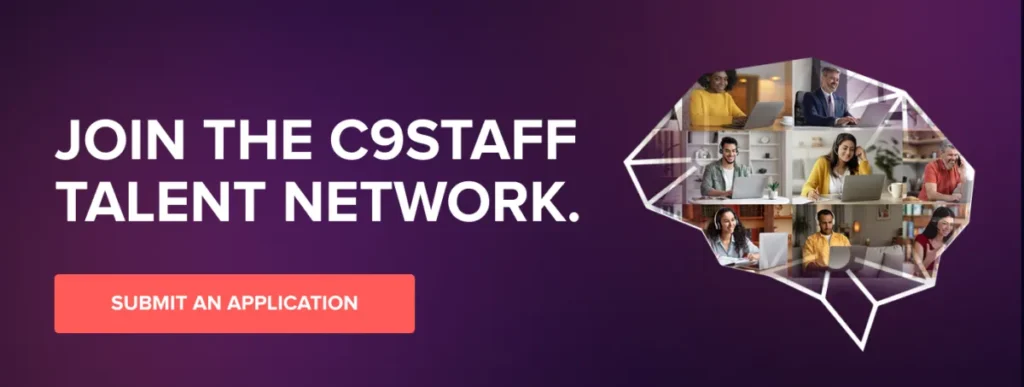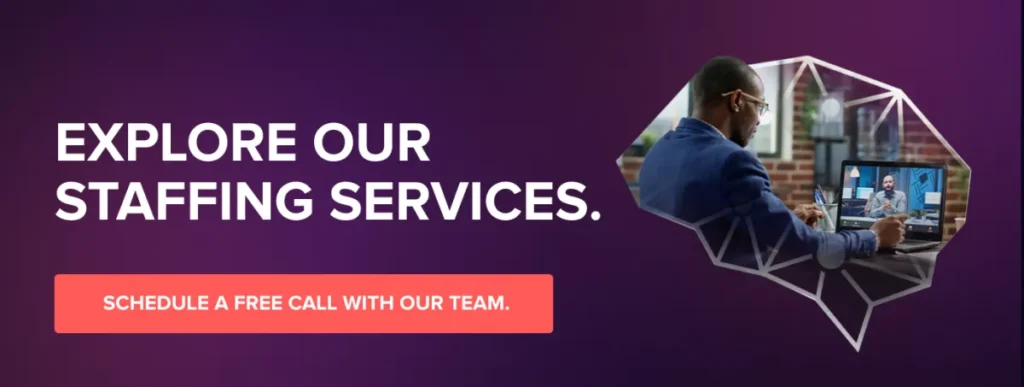Introduction

In the vast, dynamic digital landscape, content is not just king—it’s the architect of kingdoms. As you navigate through endless streams of digital content, the art and science of crafting messages that resonate deeply with audiences worldwide becomes not just valuable but indispensable. This is where a content strategist steps into the spotlight, wielding the power to shape brand narratives and influence consumer behavior like never before.
Employers seeking the optimal foundation for crafting precise hiring specifications need look no further. If your primary goal is to access the best job description template available, we invite you to download our complimentary Content Strategist Job Description. This document is meticulously designed to integrate the fundamental principles and top practices of C9Staff’s hiring methodology, ensuring you attract and identify the finest candidates for the role. Click the link below to obtain your direct download and begin refining your recruitment strategy with expert precision.
CONTENT STRATEGIST JOB DESCRIPTION TEMPLATE

A content strategist is much more than a writer or a marketer; they are the master planners of content ecosystems. In this role, you orchestrate the creation, delivery, and governance of useful, usable content. By analyzing market trends and understanding audience needs, content strategists ensure that every piece of content, from a tweet to a comprehensive report, fits into a larger, coherent story that drives engagement and business goals.
This guide is designed to walk you through everything you need to know about becoming a content strategist. From defining the role and its core responsibilities to exploring the skills you’ll need to thrive and the paths you can take to get there, this article is your comprehensive roadmap. Whether you’re looking to break into the field, aiming to refine your skills, or curious about the latest trends shaping the future of content strategy, you’ll find valuable insights and practical advice to help you succeed in this critical role.
By the end of this guide, you’ll not only understand what it takes to excel as a content strategist but also how to apply these insights to elevate your career or business in the digital age. Join us on this journey to mastering the art and science of content strategy, and discover how you can make your mark in the digital world.
Mastering Content Strategy: Essential Skills & Job Insights for Aspiring Strategists
Understanding the Role of a Content Strategist

In today’s digital-first world, the role of a Content Strategist has emerged as a cornerstone in the architecture of modern business success. As you navigate through this section, you will uncover why a robust content strategy is not just beneficial but essential for thriving in an era where digital content dictates market dynamics.
The Significance of Content Strategy
Content strategy lies at the heart of digital marketing and business operations. It’s about more than just creating appealing content; it’s about crafting powerful communication that aligns perfectly with your brand’s goals, meets the audience’s needs, and ultimately drives your business forward. For businesses, this strategic alignment means not only capturing attention but also sustaining engagement that converts into measurable results. As a content strategist, you are tasked with turning business objectives into content that resonates, ensuring that every piece of content serves a purpose and contributes to the larger business narrative.
Core Responsibilities Digging deeper, the core responsibilities of a content strategist include:
Content Planning: You will learn how to define clear objectives for content, identifying key messages that align with broader marketing strategies. This involves audience segmentation, channel selection, and messaging frameworks that ensure consistency across all platforms.
Content Development: Understand the stages of content creation from ideation to publishing. This encompasses writing, curating, and editing content, as well as collaborating with designers, writers, and other creatives to produce compelling multimedia content.
Content Measurement: You will see how strategists set metrics for content performance, track engagement, and analyze data to refine strategies. This continuous loop of measurement and adjustment is vital for improving content effectiveness and ROI.
Day-to-Day Activities To give you a practical glimpse into the life of a content strategist, imagine starting your day analyzing performance data from the latest content campaign. Based on your findings, you adjust the content calendar, prioritizing topics that have garnered the most engagement. Next, you might brainstorm with your team to generate innovative ideas for upcoming projects, ensuring each aligns with the strategic goals outlined.
In the afternoon, you could be found overseeing a content creation session, working closely with graphic designers to fine-tune an infographic that simplifies complex data for your audience. Your day might end with a review of upcoming content drafts and scheduling posts for optimal times based on user activity patterns.
Through these day-to-day activities, you as a content strategist play a dynamic and integral role in steering the content ship—a role that is both creative and analytical, demanding a unique blend of skills and a strategic mindset.
Key Skills and Qualifications

As you dive into the realm of content strategy, understanding the foundational skills and technical proficiencies required to excel in this role is crucial. This section will guide you through the essential capabilities that set the stage for success as a content strategist.
Essential Skills
Strategic Thinking: As a content strategist, you must be able to see the big picture. Strategic thinking involves understanding how content drives brand awareness, customer engagement, and ultimately, business success. It means planning not just for immediate goals but for long-term outcomes, ensuring content aligns with the company’s overall objectives.
Creativity: Your ability to think creatively is vital. Whether it’s crafting compelling headlines or devising innovative content campaigns, creativity helps in engaging audiences and making the content stand out. It’s about pushing boundaries and thinking outside the box to captivate your target audience.
Analytical Abilities: Analytical skills are indispensable. You need to interpret data from content performance metrics to understand what works and what doesn’t. This insight allows you to optimize strategies and prove the ROI of your content efforts, making your work an invaluable asset to the business.
Technical Proficiencies
SEO Expertise: Understanding SEO is non-negotiable. You should know how to optimize content to rank well in search engines, which involves using keywords effectively, understanding SEO trends, and applying these practices to increase visibility and engagement.
CMS Proficiency: Familiarity with Content Management Systems like WordPress or Drupal is essential. This skill ensures you can efficiently manage and publish content, understand the technical constraints of content implementation, and work seamlessly with web development teams.
Data Analysis Tools: Proficiency in tools such as Google Analytics or Adobe Analytics is crucial. These tools help you track user behavior, content performance, and engagement metrics, enabling you to make data-driven decisions that enhance content effectiveness.
Educational Backgrounds and Certifications
Educational Paths: Typically, content strategists come from varied educational backgrounds such as communications, journalism, marketing, or even business. However, specializing in areas directly related to digital marketing or content management through your academic courses can give you a significant edge.
Certifications: Consider obtaining certifications in Google Analytics, Content Marketing Institute, or HubSpot Content Marketing. These can not only bolster your resume but also provide you with advanced, practical knowledge that can be directly applied to your role.
As you absorb this information, think about how you can leverage these skills and qualifications to forge a path in content strategy. Whether you’re just starting out or looking to advance further, these capabilities are your toolkit for navigating the complex yet rewarding landscape of content strategy. Equip yourself with these skills, and you’ll be well on your way to becoming a leader in the digital content domain. Your journey is just beginning, and the road ahead is filled with opportunities to learn, grow, and innovate. Are you ready to take the next step?
How to Become a Content Strategist

Boarding on a career as a content strategist is an exciting journey filled with diverse opportunities and the potential for significant impact in the digital world. Whether you’re just starting out or seeking to advance further, understanding the pathways to becoming a content strategist will help set the stage for your success.
Career Pathways Your journey might begin in roles that introduce you to the fundamentals of content, such as a content writer, social media manager, or marketing coordinator. These positions provide a practical grounding in creating and managing content, which is essential for a content strategist. If you’re transitioning from related fields like marketing, journalism, or digital media, you bring valuable skills that can be leveraged in content strategy. In journalism, for example, your ability to tell compelling stories is an asset when developing brand narratives. In marketing, your understanding of market dynamics prepares you to craft strategies that engage and convert audiences.
Building Experience Gaining hands-on experience is crucial. Here are some practical steps you can take:
Internships: Look for internship opportunities in digital marketing or content creation that offer a chance to work on real projects. This not only helps you learn in a practical setting but also starts building your professional network.
Freelance Projects: Freelancing is a great way to gain diverse experience and test different industries and content types. Platforms like Upwork or Freelancer can help you find initial projects.
Portfolio Development: As you accumulate work, curate a portfolio that showcases your best content strategies and projects. Include a variety of content forms and strategies, and reflect on what you learned from each experience to demonstrate your growth and adaptability.
Learning Resources To continually advance your skills, here are some recommended resources:
Courses: Look for courses on platforms like Coursera or LinkedIn Learning that focus on content marketing, SEO, and analytics. For example, the Content Marketing Institute offers courses that are directly aligned with the needs of content strategists.
Certifications: Earning certifications can enhance your credibility; consider Google Analytics certification or HubSpot Content Marketing Certification to solidify your expertise.
Books: Keep abreast of the field with books like “Content Strategy for the Web” by Kristina Halvorson and Melissa Rach, and “Everybody Writes” by Ann Handley.
Conferences: Attend industry conferences such as Content Marketing World or HubSpot’s INBOUND. These gatherings are not only educational but are also excellent for networking and staying current with industry trends.
As you navigate through these steps, remember that your career as a content strategist is not a linear path but a dynamic journey of continuous learning and adapting. With each step you take, you’ll find opportunities to refine your skills and deepen your understanding of what it takes to excel in this field. By staying proactive in your learning and open to new experiences, you’re setting yourself up for a rewarding career that’s at the forefront of digital marketing innovation. Now, are you ready to take the next step and carve out your niche in the world of content strategy?
Crafting a Winning Job Description

In the competitive landscape of content strategy, crafting an effective job description is pivotal for employers and understanding these descriptions is equally crucial for job seekers. Whether you’re aiming to attract the top talent or you’re a professional navigating the job market, this section is designed to guide you through creating and interpreting job descriptions with precision.
For Employers: Writing an Effective Job Description
When you set out to write a job description for a content strategist, your goal is to attract candidates who not only have the necessary skills but also fit well within your company’s culture. Here’s how to structure your description:
Must-Have vs. Nice-to-Have Skills: Clearly distinguish between essential skills required to perform the job and those that would be beneficial but not mandatory. For instance, must-have skills might include experience with major content management systems and a strong grasp of SEO, while nice-to-have skills could include familiarity with data analytics tools or advanced graphic design capabilities.
Highlight Company Culture and Growth Opportunities: Candidates are not just looking for a job; they’re looking for a place where they can grow and contribute. Detail your company’s culture, values, and the growth opportunities that come with the role. This not only helps in attracting candidates who align with your company’s ethos but also sets expectations about the working environment and career progression.
Employers seeking the optimal foundation for crafting precise hiring specifications need look no further. If your primary goal is to access the best job description template available, we invite you to download our complimentary Content Strategist Job Description. This document is meticulously designed to integrate the fundamental principles and top practices of C9Staff’s hiring methodology, ensuring you attract and identify the finest candidates for the role. Click the link below to obtain your direct download and begin refining your recruitment strategy with expert precision.
CONTENT STRATEGIST JOB DESCRIPTION TEMPLATE

For Job Seekers: Interpreting Job Descriptions
As a job seeker, a job description is your first insight into what a company expects from its employees and what it can offer you in return. Here’s how to read and use this information effectively:
Identify Key Requirements: Scan the job description for must-have skills and qualifications—these are your priorities when tailoring your application. Make sure you clearly showcase these skills in your resume and cover letter.
Assess Company Fit: Look for information about the company culture and values. Do they mention teamwork, innovation, or perhaps a commitment to learning and development? Reflect on whether these align with your personal and professional aspirations.
Tailor Your Application: Use the language and keywords found in the job description to tailor your resume and cover letter. This not only helps in passing through Applicant Tracking Systems (ATS) but also shows that you are attentive and have a genuine interest in the role.
Prepare for Interviews: Use the responsibilities and skills listed in the job description to anticipate interview questions. Prepare examples that demonstrate your proficiency in these areas, focusing on how your contributions in past roles align with the expectations of this new position.
Are you ready to supercharge your career and land your dream job? C9Staff is here to help you make that leap. We invite you to click the link below and submit your resume to our talent acquisition department. If your qualifications align with our client requirements, we will reach out to discuss potential opportunities that match your skills and aspirations. Don’t miss this chance to connect with leading employers and take your professional journey to the next level.

The Future of Content Strategy
As you navigate through your career as a content strategist, it’s essential to stay ahead of the curve in a field that is rapidly shaped by advancing technologies and evolving market demands. This section will explore key trends and the future skills you’ll need to not just survive but thrive in the dynamic world of content strategy.
Emerging Trends in Technology The digital landscape is continually transformed by innovations in technology, with significant implications for content strategy:
Artificial Intelligence and Machine Learning: AI is revolutionizing content creation by enabling more personalized content experiences. Machine learning algorithms can analyze user behavior to tailor content precisely to audience needs, increasing engagement and conversion rates.
Advanced Data Analytics: The ability to analyze vast amounts of data in real-time is crucial. This trend allows for more precise content effectiveness tracking and helps strategists make informed decisions quickly, adapting strategies to reflect real-time feedback.
Voice Search and IoT: As voice search becomes more prevalent and the Internet of Things (IoT) expands, content strategists must adapt their content for these platforms. This includes optimizing for voice search queries and creating content for a variety of connected devices.
Future Skills for Content Strategists As technologies evolve, so too must the skill set of a content strategist. To remain competitive and effective, you’ll need to develop:
Adaptability to New Technologies: Staying current with technology trends and understanding how to integrate new tools into your content strategy will be essential.
Advanced Data Interpretation: Beyond basic analytics, the ability to derive complex insights from data will become a crucial skill. Understanding data not just at a surface level but also being able to predict trends and user behaviors will set you apart.
Deeper Understanding of User Experience Design: UX is becoming an integral part of content strategy. A thorough understanding of how content fits into the overall user experience will be necessary, ensuring that content is not only engaging but also user-centric.
Upskilling for the Future To prepare for these future demands, consider the following actions:
Continuous Learning: Engage in ongoing education through courses in advanced analytics, AI applications in content strategy, and UX design. Platforms like Coursera, Udemy, and LinkedIn Learning are excellent resources.
Professional Development: Attend industry conferences such as the Content Marketing World or Digital Summit. These events are great for learning from leading experts and networking with peers.
Practical Application: Experiment with new tools and technologies as they emerge. Whether through personal projects or pilot programs within your current role, hands-on experience is invaluable.
Employers looking to enhance their team with the perfect Content Strategist are invited to discover how C9Staff can streamline your hiring process. By clicking the link below, you can schedule a complimentary exploratory call with one of our dedicated account managers today. During this call, we will attentively listen to your specific needs and provide endorsements for potential candidates at no cost, helping you evaluate the very best talent available at competitive prices. Take the first step towards securing top-tier talent tailored to your organizational needs by scheduling your free call now.

Conclusion: Harnessing the Power of Content Strategy

As we reach the end of this comprehensive guide to the role of a content strategist, it’s clear that the intersection of creativity, strategic thinking, and technical proficiency forms the cornerstone of effective content strategy. Throughout this article, we’ve explored the diverse responsibilities that define a content strategist—from planning and developing content to measuring its impact in line with business goals.
We’ve dug into the essential skills needed for success in this role, such as SEO expertise, mastery of Content Management Systems, and a robust ability to analyze data to inform strategy. These technical skills, combined with a creative and strategic mindset, equip content strategists to adapt and thrive in a rapidly evolving digital landscape.
The real-world examples and insights from industry experts highlighted throughout this guide underscore the practical applications and significant impact of content strategy across various sectors. Whether it’s transforming a brand’s digital presence, enhancing user engagement, or driving business growth, the role of a content strategist is both dynamic and critical.
If you’re aspiring to forge a career in content strategy, consider this your cue to take action. Start by enhancing your educational background and skill set with targeted courses and certifications. Immerse yourself in the field through internships or freelance projects to gain practical experience and build a compelling portfolio.
For those in hiring roles, let the insights shared here guide you to refine your recruitment strategies. Look for candidates who not only have the necessary technical skills but also embody strategic and creative thinking capabilities that can drive your business forward.
Lastly, for everyone engaged in this field, remain proactive about keeping up with emerging trends and technologies. The future of content strategy is continuously shaped by innovations, and staying updated will ensure that your strategies remain effective and relevant.
You’ve now got the insights and tools at your disposal—use them to carve out a successful path in the world of content strategy, either by advancing your career or by hiring and nurturing top talent. Let’s take these learnings and turn them into action. Your journey as a content strategist or as a leader nurturing such talent begins today.




